
H8 DSP
Digital Interface Processor
User’s manual
2
Index
1. PRODUCT DESCRIPTION / SAFETY PRECAUTIONS ...................................................................................................... 03
2. PACKAGING CONTENTS ................................................................................................................................................... 03
3. H8 DSP and DRC INSTALLATION ..................................................................................................................................... 04
4. CONNECTION PANELS – DESCRIPTION ......................................................................................................................... 05
4.1 Multipolar connector ................................................................................................................................................ 05
4.2 Input signals ............................................................................................................................................................. 06
4.3 Output signals .......................................................................................................................................................... 06
4.4 Inputs - remote control outputs and power supply.............................................................................................. 07
4.5 Controls and settings .............................................................................................................................................. 09
5. CONNECTIONS .................................................................................................................................................................. 10
5.1 Power supply and remote turn on ......................................................................................................................... 10
5.2 How to turn the h8 dsp on / off ............................................................................................................................. 10
5.3 Personal computer and digital remote control (drc) ............................................................................................ 11
5.4 High-level input signals ........................................................................................................................................... 11
5.5 Low-level input signals ........................................................................................................................................... 12
5.6 Optical in digital input ............................................................................................................................................... 12
5.7 Output signals .......................................................................................................................................................... 13
6. HOW TO SETUP THE H8 DSP WITHOUT A PC .....................................................................................................................14
6.1 How to calibrate the master front-rear input sensitivity .................................................................................... 14
6.2 Source de-equalization ............................................................................................................................................ 15
6.3 Amplifiers sensitivity calibration ............................................................................................................................ 17
6.4 How to calibrate the aux in input sensitivities ..................................................................................................... 17
7. H8 DSP SOFTWARE AND DRIVERS INSTALLATION / UNINSTALLATION GUIDE ....................................................... 18
7.1 PC software installation guide ............................................................................................................................... 18
7.2 Drivers installation guide ........................................................................................................................................ 20
7.3 H8 dsp software uninstall ....................................................................................................................................... 21
8. H8 DSP INSTALLATION GUIDE USING A PC ................................................................................................................... 22
8.1 Selecting the master (front / rear) inputs and outputs - target mode .............................................................. 22
8.2 Offline mode ............................................................................................................................................................. 29
8.3 Adjusting acoustic reproduction ............................................................................................................................ 30
8.4 Device info ................................................................................................................................................................. 30
8.5 “File” main menu ...................................................................................................................................................... 30
8.6 “Config” main menu ................................................................................................................................................. 32
8.7 Selected input ........................................................................................................................................................... 33
8.8 Channel map ............................................................................................................................................................. 33
8.9 Select channel .......................................................................................................................................................... 33
8.10 Filter settings ......................................................................................................................................................... 34
8.11 Set distance and delay .......................................................................................................................................... 36
8.12 Graphic equalizer ................................................................................................................................................... 38
8.13 Output level ............................................................................................................................................................ 39
8.14 Memory ................................................................................................................................................................... 40
9. TROUBLESHOOTING ......................................................................................................................................................... 41
9.1 Synchronization with a pc ....................................................................................................................................... 41
9.2 Background noise ..................................................................................................................................................... 41
9.3 Firmware upgrade .................................................................................................................................................... 42
9.4 Rescue mode ............................................................................................................................................................ 43
10. TECHNICAL SPECIFICATIONS .......................................................................................................................................... 44





















